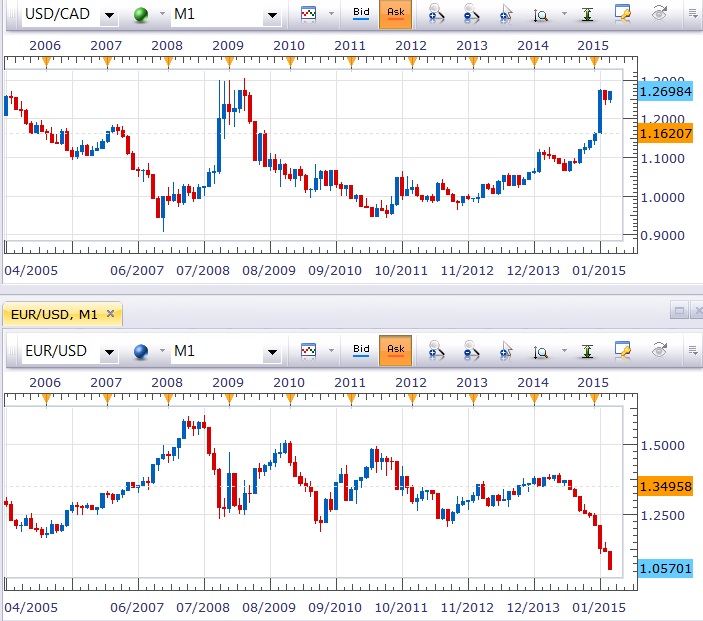Can't The US Dollar Keep Center Stage? |
By Ted
Twietmeyer |
| Since the Eurodollar first came out many years ago, the
US dollar has always been the underdog when compared to the Eurodollar.
One Eurodollar required about US $1.35 to buy one over the past
10 years. With Canada, it has historically been the opposite - it required
more than one Canadian Dollar to buy just one US dollar. Most people who enter Canada on vacation are wise to head straight for a dollar exchange office or a bank to take advantage of the exchange rate. Even today, many stores, hotels and restaurants refuse to give you fair value for your American dollar when you pay for something - they pocket the difference at their bank. Many Canadians may openly show their dislike of Americans when they deal with you. It is wise to enter Canada (or leave it) only when a bank or exchange office is open. Or arrive there with Canadian dollars already in your pocket. From 2011 to early 2013 one Canadian dollar (blue highlighted value below) was close to the value of one US dollar, as shown below in the top chart below covering 10 years. Only briefly in 2007 and 2011 was the Canadian dollar more valuable than a US dollar. Now the Canadian dollar has shot up again - to almost $1.27: |

| Charts courtesy of Forex Capital Markets Inc. Bottom chart also covers the past 10 years. Value of one European dollar (Euro) has plummeted when compared to one US dollar (blue number.) Each day the Euro slightly recovers (blue bars) then drops yet again (red bars.) Currency exchange for Europe opens at 8AM London time. On March 11, 2015, from 4AM EST to 6:30AM EST the value of one Eurodollar dropped from $1.068 to $1.056. While this decrease in the Euro value may not sound significant, consider that the actual value of almost all currencies is measured out to 5 decimal places. In normal daily trading, usually only the last 3 digits change in value. Not all five digits, and not whole dollars like it has today. Another sudden decrease in the value of the Euro across the world occurred early in the morning March 11, 2015, a full 4 hours before the NY currency exchange opened several hours later (this exchange is not Wall St.) With Europe the dominant trading force in the world during these early morning hours while most of America is still asleep, it appears that even Europe has little faith in the Euro. So what could all this mean? For weeks the much-maligned US dollar has taken center stage on world financial markets. Despite US economic woes, even worse economic troubles may have arisen in Europe for the Euro. The European economy may be even worse for the Euro, than how the American economy negatively affected the US dollar. Many of the same problems over the past years in America - decreasing jobs and interest rates, increasing unemployment, decreasing mortgages, etc... are increasingly affecting the European economy in a similar way. In early March 2015, the European Central Bank began implementing their version of "quantitative easing" as European bank leaders attempt to stop the European economy (and their over-valued Euro) from hemorrhaging to death. Is the increasing value of the US dollar on the world stage just a illusion? Time will tell. Maybe. Ted Twietmeyer |
| Donate to Rense.com Support Free And Honest Journalism At Rense.com | Subscribe To RenseRadio! Enormous Online Archives, MP3s, Streaming Audio Files, Highest Quality Live Programs |